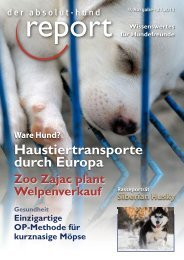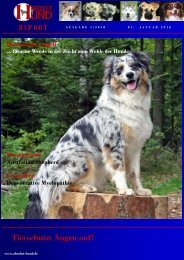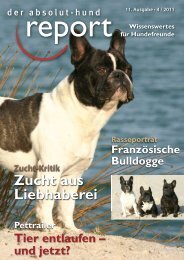Wissenschaft
Wissenschaft
Wissenschaft
Erfolgreiche ePaper selbst erstellen
Machen Sie aus Ihren PDF Publikationen ein blätterbares Flipbook mit unserer einzigartigen Google optimierten e-Paper Software.
<strong>Wissenschaft</strong><br />
Danksagungen<br />
Finanzielle und logistische Unter stüt -<br />
zung wurde von der IEMT Österreich<br />
durch den Verein zur Förderung des<br />
Konrad Lorenz Institutes Grünau und<br />
von der Universität Wien vorgesehen.<br />
Besonderer Dank gilt den Mitgliedern<br />
unseres Mensch-Tier-Interaktions-Team,<br />
Dorothy Gracey und Elisabeth Spielauer,<br />
welches an einer Reihe von Möglich -<br />
keiten beteiligt waren. Danke auch an<br />
Anna Schöbitz für die technische Unter -<br />
stützung. Wir wissen die kritische Durch -<br />
sicht unseres Manuskripts von Jon Day,<br />
Katharina Hirschenhauser und Isabella<br />
Schreiber zu schätzen.<br />
Referenzen<br />
Aureli, F., deWaal, F.B.N., 2000. Natural Conflict Reso -<br />
lution. University of California Press, Berkley,<br />
409 pp.<br />
Borkenau, P., Ostendorf, F., 2008. NEO-FFI. NEO-Fünf-<br />
Faktoren-Inventar nach Costa und McCrae. 2. neu<br />
normierte und vollständig überarbeitete Auflage.<br />
Manual.<br />
Hogrefe, Göttingen, 112 pp.<br />
Bowlby, J., 1999. Attachment and Loss. Basic Books,<br />
New York, 428 pp. (reprint from 1974).<br />
Costa, P.T., McCrae, R.R., 1992. RevisedNEOPersonality<br />
Inventory (NEO PI-R) andNEO<br />
Five-Factor Inventory (NEO-FFI): Professional Manual:<br />
Psychological Assessment Resources, Odessa,<br />
Florida.<br />
Creel, S., 2005. Dominance, aggression and glucocorticoid<br />
levels in social carnivores.<br />
J. Mammal. 86, 255–264.<br />
Curley, J.P., Keverne, E.B., 2005. Genes, brains and<br />
mammalian social bonds. TREE 20, 561–567.<br />
DeVries, C.A., Glasper, E.R., Detillion, C.E., 2003. Social<br />
modulation of stress responses. Physiol. Behav. 79,<br />
399–407.<br />
Feaver, J., Mendl, M., Bateson, P., 1986. A method for<br />
rating the individual distinctiveness of domestic<br />
cats. Anim. Behav. 34, 1016–1025.<br />
Friedmann, E., Thomas, S.A., Eddy, T.J., 2000.<br />
Companion animals and human health: physical<br />
and cardiovascular influences. In: Podberscek, A.L.,<br />
Paul, E., Serpell, J.A.<br />
(Eds.), Companion Animals and Us: Exploring the<br />
Relationships Between People and Pets.<br />
Cambridge University Press, Cambridge, UK, pp.<br />
125–142.<br />
Goodson, J.L., 2005. The vertebrate social behaviour<br />
network: evolutionary themes and variations.<br />
Horm. Behav. 48, 11–22.<br />
Gosling, S.D., 2001. From mice to men: what can we<br />
learn about personality from animal research?<br />
Psychol. Bull. 127, 45–86.<br />
Gosling, S.D., John, O.P., 1999. Personality dimensions<br />
in nonhuman animals: a crossspecies review. Curr.<br />
Dir. Psychol. Sci. 8, 75.<br />
Groothuis, T.G.G., Carere, C., 2005. Avian personalities:<br />
characterization and epignesis.<br />
46<br />
der absolut-hund report • 3 / 2011<br />
Neurosci. Biobehav. Rev. 29, 137–150.<br />
Hart, L., 1995. Dogs as human companions: a review<br />
of the relationship. In: Serpell,<br />
J. (Ed.), The Domesticated Dog: Its Evolution, Beha -<br />
viour and Interaction with People. Cambridge<br />
University Press, Cambridge, UK, pp. 161–178.<br />
Hennessy,M.B., Williams, M.T., Miller, D.D., Douglas,<br />
C.W., Voith, V.L., 1998. Influence of male and female<br />
patters on plasma cortisol and behaviour: can<br />
human interaction reduce the stress of dogs in a<br />
public animal shelter? Appl. Anim. Behav. Sci. 61,<br />
63–77.<br />
Hirschenhauser, K., Kotrschal, K., Möstl, E., 2005. A<br />
synthesis of measuring steroid metabolites in<br />
goose feces. Ann. NY Acad. Sci. 1046, 138–153.<br />
Johannson, E.E., 1999. Human–animal bonding: an<br />
investigation of attributes. PhD Thesis. University<br />
of Alberta.<br />
Jones, A.C., Josephs, R.A., 2006. Interspecies hormonal<br />
interactions between man and the domestic<br />
dog (Canis familiaris). Horm. Behav. 50, 393–400.<br />
Kerepesi, A., Jonsson, G.K., Miklòsi, À., Topàl, J., Csànyi,<br />
V., Magnusson, M.S., 2005.<br />
Detection of temporal patterns in dog–human interaction.<br />
Behav. Proc. 70, 69–79.<br />
Koolhaas, J.M., Korte, S.M., Boer, S.F., Van Der Vegt, B.J.,<br />
Van Reenen, C.G., Hopster,<br />
H., De Jong, I.C., Ruis, M.A.W., Blokhuis, H.J., 1999.<br />
Coping styles in animals: current status in behavior<br />
and stress-physiology. Neurosci. Biobehav.<br />
Rev. 23, 925–935.<br />
Kotrschal, K., Bromundt, V., Föger, B., 2004. Faktor<br />
Hund. Eine sozio-ökonomische Bestandsauf -<br />
nahme der Hundehaltung in Österreich. Czernin-<br />
Verlag, Wien, 96 pp.<br />
Kotrschal, K., Ortbauer, B., 2003. Behavioural effects<br />
of the presence of a dog in the classroom.<br />
Anthrozoös 16, 147–159.<br />
Koyama, T., Omata, Y., Saito, A., 2003. Changes in salivary<br />
cortisol concentrations during a 24-hour<br />
period in dogs. Horm. Metabol. Res. 35, 355–357.<br />
Kummer, H., 1978. On the value of social relationships<br />
to nonhuman primates: a heuristic scheme. Soc.<br />
Sci. Inform. 17, 687–705.<br />
McCrae, R.R., Costa, P.T., 2003. Personality in<br />
Adulthood, second edition. Guilford Press, NY, 268<br />
pp.<br />
McCune, S., McPherson, J.A., Bradshaw, J.W.S., 1995.<br />
Avoiding problems. In: Robinson,<br />
I. (Ed.), TheWaltham Book of Human–Animal<br />
Interactions. Pergamon Press, Kidlington, pp. 71–<br />
86.<br />
McEwen, B.S., Wingfield, J.C., 2003. The concept of<br />
allostasis in biology and biomedicine. Horm.<br />
Behav. 43, 2–15.<br />
Mehta, P.H., Jones, A.C., Josephs, R.A., 2008. The social<br />
endocrinology of dominance: basal testosterone<br />
predicts cortisol changes and behaviour following<br />
victory and defeat. J. Person. Soc. Psychol. 94,<br />
1078–1093.<br />
Nakagawa, S., 2004. A farewell to Bonferroni: the problems<br />
of low statistical power and publication<br />
bias. Behav. Ecol. 15, 1044–1045.<br />
O’Farrell, V., 1995. Effects of owner personality and<br />
attitudes on dog behaviour. In:<br />
Serpell, J. (Ed.), The Domesticated Dog its Evolution<br />
Behaviour and Interaction with People. Cam bridge<br />
University Press, Cambridge, UK, pp. 151–158.<br />
Palme, R., Möstl, E., 1997. Measurement of cortisol<br />
metabolites in faeces of sheep as a parameter of<br />
cortisol concentration in blood. Z. Säugetierkunde<br />
– Mamm. Biol. 62 (Suppl. II), 192–197.<br />
Panksepp, J., 1998. Affective Neuroscience. The Foun -<br />
dations of Human and Animal Emotion. Oxford<br />
University Press, NY, 466 pp.<br />
Podberscek, A.L., Gosling, S.D., 2000. Personality re -<br />
search on pets and their owners: conceptual issues<br />
and review. In: Podberscek, A.L., Paul, E., Serpell,<br />
J.A. (Eds.),<br />
Companion Animals and Us: Exploring the Rela tion -<br />
ships Between People and Pets. Cambridge Uni -<br />
ver sity Press, Cambridge, UK, pp. 143–167.<br />
Podberscek, A.L., Paul, E., Serpell, J.A. (Eds.), 2000.<br />
Companion Animals and Us: Exploring the Rela -<br />
tion ships Between People and Pets. Cam bridge<br />
University Press, Cambridge, UK, 335 pp.<br />
Prato-Previde, E., Fallani, G., Valsecchi, P., 2006. Gen der<br />
differences in owners interacting with pet dogs:<br />
an observational study. Ethology 112, 63–73.<br />
Range, F., Horn, L., Viranyi, Z., Huber, L., 2009. The ab -<br />
sence of reward induces inequity aversion in dogs.<br />
Proc. Natl. Acad. Sci. USA 106, 340–345.<br />
Robinson, I., 1995. The Waltham Book of Human–Ani -<br />
mal Interaction: Benefits and Responsibilities of<br />
Pet Ownership. Pergamon Press, Kidlington, 148 pp.<br />
Scheiber, I.B.R.,Weiss, B.M., Frigerio, D., Kotrschal, K.,<br />
2005. Active and passive social support in families<br />
of Greylag geese (Anser anser). Behaviour 142,<br />
1535–1557.<br />
Schleidt,W.M., Shalter, M.D., 2003. Co-evolution of<br />
humans and canids. Evol. Cogn. 9, 57–71.<br />
Scott, J.P., Fuller, J.L., 1965. Genetics and the Social<br />
Behavior of the Dog. Univ. Chicago Press, Chicago,<br />
468 pp.<br />
Serpell, J.A., 1986. In the Company of Animals. Basil<br />
Blackwell, Oxford, 283 pp.<br />
Serpell, J.A. (Ed.), 1995. The Domestic Dog. Cam -<br />
bridge University Press, Cambridge, 268 pp.<br />
Serpell, J.A., 1996. Evidence for association between<br />
pet behavior and owner attachment levels. Appl.<br />
Anim. Behav. Sci. 47, 49–60.<br />
Sih, A., Bell, A.M., Johnson, J.C., Ziemba, R.E., 2004.<br />
Behavioral syndromes: an integrative overview.<br />
Quart. Rev. Biol. 79, 241–277.<br />
Svartberg, K., Tapper, I., Temrin, H., Radesäter, T.,<br />
Thorman, S., 2005. Consistency of personality<br />
traits in dogs. Anim. Behav. 69, 283–291.<br />
Tinbergen, N., 1963.Onaims andmethods of ethology.<br />
Zeitschrift für Tierpsychologie 20, 410–433.<br />
Topàl, J., Miklòsi, À., Csànyi, V., 1997. Dog–human relationship<br />
affects problem solving behavior in the<br />
dog. Anthrozoös 10, 214–223.<br />
Turner, D.C., Bateson, P. (Eds.), 2005. The Domestic<br />
Cat, 2nd ed. Cambridge Univ. Press, Cambridge,<br />
244 pp.<br />
Vas, J., Topál, J., Gácsi, M., Miklósi, Á., Csányi, V., 2005.<br />
A friend or an enemy? Dogs’ reaction to an unfamiliar<br />
person showing behavioural cues of threat<br />
and friendliness at different times. Appl. Anim.<br />
Behav. Sci. 94, 99–115.<br />
Vilà, C., Savolainen, P., Maldonado, J.E., Amorim, I.R.,<br />
Rice, J.E., Honeycutt, R.L., Crandall,<br />
K.A., Lundeberg, J., Wayne, R.K., 1997. Multiple and<br />
ancient origins of the domestic dog. Science 276,<br />
1687–1689.<br />
Voith, V.L., 1985. Attachment of people to companion<br />
animals. Vet. Clin. N. Am.: Small Anim. Pract. 15,<br />
289–296.<br />
Von Holst, D., 1988. The concept of stress and its relevance<br />
for animal behavior. Adv. Behav. 27, 1–131.<br />
Wilson, E.O., 1984. Biophilia. Harvard University Press,<br />
Harvard, 157 pp.<br />
Wilson, D.S., Clark, A.B., Coleman, K., Dearstyne, T.,<br />
1994. Shyness and boldness in humans and other<br />
animals. TREE 9, 442–446.<br />
Wilson, C.C., Turner, D.C. (Eds.), 1998. Companion<br />
Animals in Human Health. Sage, London, 310 pp.<br />
Zimen, E., 1972.Wölfe und Königspudel - vergleichende<br />
Verhaltensbeobachtungen.<br />
R. Piper Verlag, München, 232 pp.<br />
Zimen, E., 1978. DerWolf. Meyster Verlag, Wien,<br />
München, 448 pp.<br />
Übersetzung: Antje Henze<br />
www.passion4dogs.de








